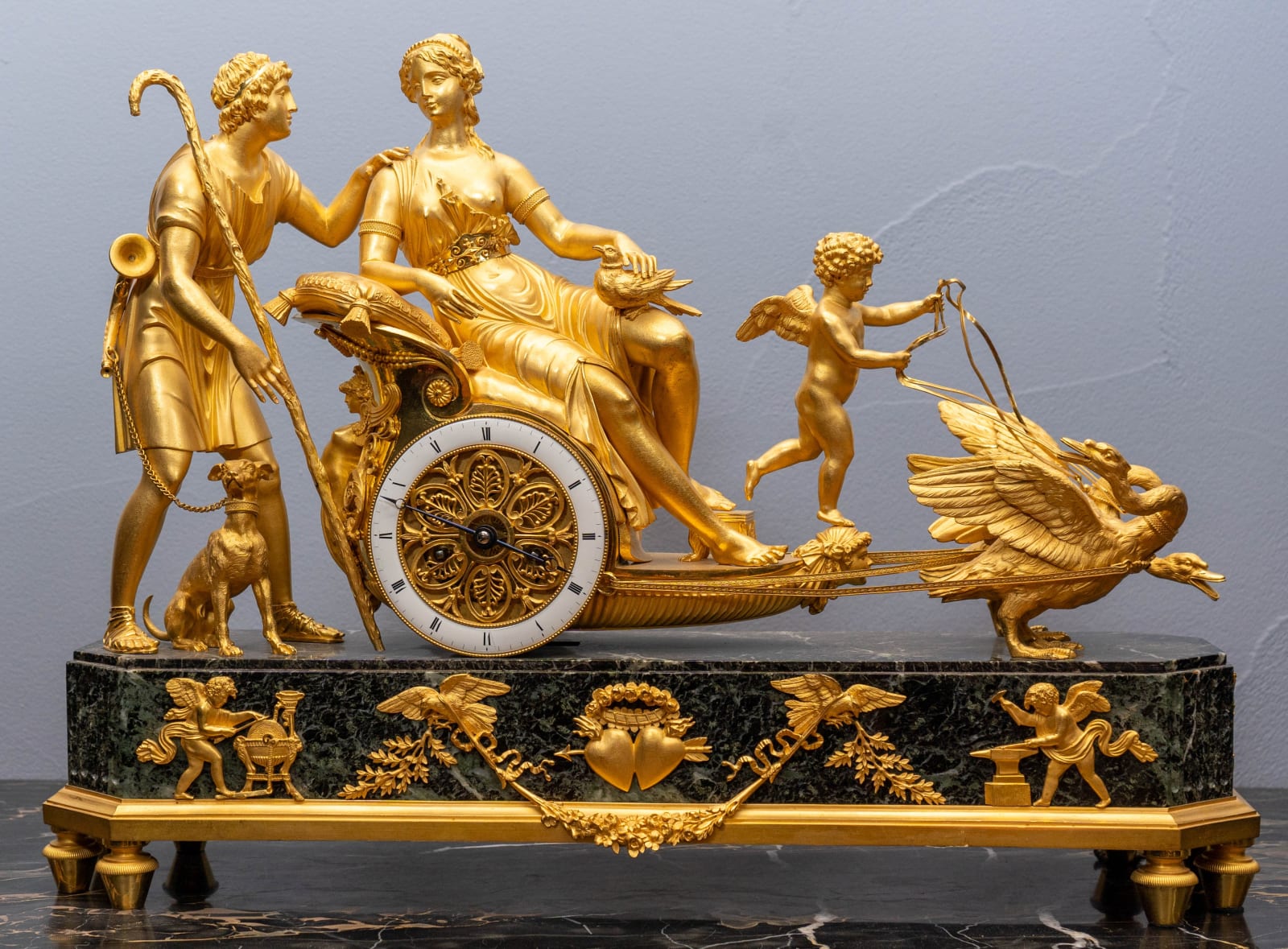André-Antoine Ravrio (attributed to)
Literature
Hans Ottomeyer and Peter Pröschel, “Vergoldete Bronzen”, 1986, p. 353, pl. 5.8.7, illustrating a clock with movement by Ridel à Paris and a very similar case of circa 1808 attributed to André-Antoine Ravrio with standing spaniels and inscribed on the drapery “L’Amour conduit par la Fidélité”; and p. 692, pl. 18a, illustrating another Ravrio chariot clock, 1806-8 with a young Cupid and chariot drawn by a single standing spaniel, made for the boudoir of Princess Caroline Murat at the Elysée Palace.
Tardy, “Les Plus Belles Pendules Françaises”, 1994, p. 298, illustrating a very similar clock with two standing spaniels in the Ecole d’Horlogerie, Dreux.
Pierre Kjellberg, “Encyclopédie de la Pendule Française”, 1997, p. 418, fig. D, illustrating another example with identical chariot and figure of Cupid, slightly different dogs and an identical base bearing the same inscription as above.
Elke Niehüser, “Die Französische Bronzeuhr”, 1997, p. 243, pl. 928, illustrating a very similar clock with standing spaniels.
A superb Empire gilt bronze and verde antico marble chariot clock, with gilt Roman numerals and pierced gilt brass hands for the hours and minutes set within the wheel of a chariot. The movement with anchor escapement, silk thread suspension, striking on the hour and half hour, with outside count wheel. The magnificent case attributed to André-Antoine Ravrio formed as a wreath-hung chariot with a swan at the back and ridden by a winged Cupid with flowing loin cloth, holding a flaming torch in his left hand, his right hand holding reins attached to a pair of hounds, emblematic of fidelity; upon a shaped marble base cast with doves and ribbon-tied wreaths centred by a mask and putti supporting drapery on turned gilt bronze toupie feet
Paris, date circa 1810
Height 44 cm; width 61 cm depth 17cm
André-Antoine Ravrio’s (1759-1814) celebrated oeuvre included a number of chariot clocks including a very similar example, which was delivered in 1807 for the ‘boudoir d’argent’ of Empress Josephine at the Elysée Palace. Unlike other comparable models the present hounds are not static but leap in the air so as to convey greater dynamism.
One of the greatest French bronziers of the pre and post Revolution period, Ravrio was a highly successful, well-respected businessman and an exceptionally gifted artist. In addition to bronze work he wrote and published poetry and plays. Ravrio came from an interesting and well-connected background. His maternal grandfather was the eminent ébéniste François Vandercruse whose son, (Ravrio’s uncle), was Roger Vandercruse, known as Lacroix, while Ravrio’s mother was sister-in-law to the royal ébéniste, J- H Riesener. After attending a good school, Ravrio joined the Académie. He then trained as a fondeur under his father, André, whose family had been fondeurs since 1661. On Pierre-Philippe Thomire’s recommendation Ravrio was introduced to the comte d’Artois, 1774. Three years later he was received as a maître-fondeur and afterwards joined J-B Disnematin-Dorat, a Parisian doreur-argenteur. In 1790 Ravrio married Disnematin’s daughter; his father-in-law sold him his warehouse stock, which Ravrio rapidly expanded. He also built up an eminent clientele and supplied to ébénistes such as Georges Jacob, his uncle, Riesener and Guillaume Benneman.
Although Ravrio enjoyed success during Louis XVI’s reign, he achieved far greater fame under Napoleon. He took part in the first Exposition de l’Industrie, Paris, 1803 and then won a silver medal there in 1806. The same year he supplied a number of bronze furnishings for Empress Joséphine’s apartments in the Tuileries and in 1810 was appointed as the Emperor’s chief bronzier. As such he supplied some of the finest pieces from girandoles, candelabras and lamps as well as ornate furniture mounts and an array of fine sculptured clock cases to many of the Imperial residences at the Tuileries, Fontainebleau, Saint-Cloud, Versailles, Compiègne and Rambouillet. Ravrio also worked for the Quirinal in Rome, Monte-Cavallo, for Stupinigi near Turin, King Ludwig of Holland and many other notable figures. In order to meet demand he employed over a hundred craftsmen. Today one can also admire his work among the finest collections including the Stedelijk Museum Lakenhal, the Upper Belvedere Vienna, Musée Massena Nice and the Residenz, Munich.
